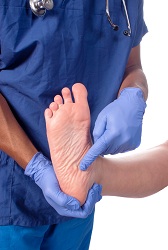Fascial tear or rupture

Heel Pain
It is estimated that 10% of Americans suffer from heel pain. The most common cause of heel pain is plantar fasciitis and ranks #3 on the list of most common running-related injuries. This is what led Groucho Marx to remark, “Time wounds all heels.” Fortunately, effective treatments for heel pain are available and 85% of patients improve without surgery after 3 months.
The Plantar Fascia
The arch is supported by muscles, tendons, ligaments, and a structure called the plantar fascia. This fascia is a very strong, ligament-like structure that attaches to the bottom of the heel bone and spans out to the bottom of the toe joints. It does not stretch when placed under tension. The fascia is only capable of stretching 4-5% before it begins to tear. With every step we take, the plantar fascia is placed under tension on average anywhere from 5,000 to 10,000 times every day.
Plantar Fascial Tear
Injuries occur when an abnormal force is placed on a normal tissue or a normal force is placed on an abnormal tissue. The plantar fascia is susceptible to overloading during running and even everyday activities. When that load is too great, the fascia can tear. Sometimes these are small in size and other times they are large. Small tears typically heal, if the tissue is rested. Larger tears can heal, but they take longer. As with any tissue in the human body, when inadequate time is provided for healing, injury to the plantar fascia will form into scar tissue. Scar tissue isn’t as strong as normal fascia and thus creates a weak area which may lead to additional tearing. Over time, this causes a condition called fasciosis.
Plantar Fascial Rupture
Just as with plantar fascial tears, a rupture occurs when too much force is exerted all at once or over time through the foot. A tear is an incomplete injury. A rupture is a complete tear through the fascia. Understandably then, a rupture is a more severe injury and takes longer to heal.
Treatment
Both plantar fascial tears and ruptures are treated conservatively. Treatment typically consists of rest, ice, immobilization, anti-inflammatory medication, and activity modifications. For runners, this may mean a few weeks off running and reliance on cross training to keep in shape. An emerging treatment for plantar fascial injuries is the use of PRP and amnion injections. PRP, or platelet-rich plasma, is a concentrated solution of platelets from the patient’s own blood. Platelets are essentially small packets of material which help in blood clotting and tissue repair. They release growth factors which help tissue heal more quickly. Amnion is a layer of tissue surrounding a human fetus. This layer contains growth factors and helps modulate tissue healing. It has been used for nearly a century in various parts of the body. Recent research has led to its use in sports medicine to help tendons, fascia, and joints heal better. Some patients ask whether the tissue needs to be repaired, or surgically reconnected. The answer is no for two simple reasons. A surgical repair would cause more scarring and thus lead to more pain. Also, a ruptured plantar fascia frays rather than tearing cleanly, thus making it impossible for sutures to hold either end well. In the end, the reduced tension in the fascia will decrease the chances of fasciitis or fasciosis occurring in the future.
This information is not intended to diagnose, treat, or prevent any injury or disease. It is intended to serve as an overview of running-related injuries and should not be used as a substitute for sound medical advice from a doctor or therapist.


